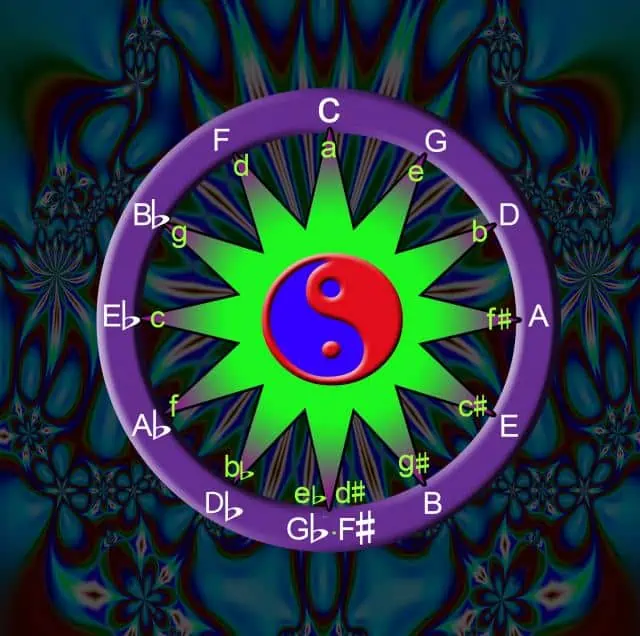The Ebm guitar chord, a.k.a E flat minor, is one of the rarer chords. There are only a few keys that naturally contain Ebm. Of course, it can always be borrowed from one of those keys in a song that’s in a more common key to add some spice to the mix.
Having said that, it’s quite a nice chord. While I’ll cover some theory, because a little bit of theory is always useful even if it’s not as exciting as just jamming, I’ll show you a bunch of ways you can play the Ebm chord.
You can then pick and choose which work for you, although it never hurts to learn different ways to play a chord. Then you can match the versions to whatever you’re playing.
Ebm Guitar Chord Theory
To get the Ebm chord, let’s look at the Eb natural minor scale. Here is the Eb natural minor scale which according to the circle of fifths has six flats:
Eb F Gb Ab Bb Cb Db
1 2 3 4 5 6 7
We take the first, third, and fifth intervals to get the Ebm chord:
Eb, Gb, Bb
Diatonic Chords
We can get which keys naturally contain Ebm by looking at diatonic chords. The intervals are in Roman numerals. Small letters indicate minor chords, capital letters indicate major chords, and the chords with a little circle indicate diminished chords.
For the natural minor keys, the following are major, minor, and diminished chords:
i, iiº, III, iv, v, VI, VII
For major keys, the formula is:
I, ii, iii, IV, V, vi, viiº
The keys you will naturally find Eb minor in are:
Eb minor (1 chord)
Bb minor (4 chord)
Db major (2 chord)
Gb major (6 chord)
Cb major (3 chord)
The number after these keys indicate what interval the Eb is in the scale of these keys. They’re also useful for chord progressions.
How to Play the Ebm Guitar Chord
Well, now that you have some basic theory under your belt, let’s get to ways to play Ebm. With most of these chords you’ll have strings you need to avoid playing. You can’t play any of the open strings as none of the open strings are Eb, Gb, or Bb.
Three Finger Ebm Chord
Version 1
This version sounds beautiful. It’s also pretty easy to play. Great for picking or plucking with your fingers but also easy to strum. It may take some practice to avoid the strings you aren’t meant to play, but you’ll get there.
Index finger: 2nd fret, 1st string
Middle finger: 3rd fret, 3rd string
Ring finger: 4th fret, 2nd string
Version 2
This version definitely sounds sad. It’s still easy to position your fingers and despite the way it looks, you can mute the necessary strings with some creative positioning of your thumb and forefinger.
Index finger: 3rd fret, 3rd string
Middle finger: 4th fret, 4th string
Ring finger: 4th fret, 2nd string
Version 3
This version is a bit of a stretch. I prefer to play that Eb on the 5th string with my pinky since it’s got extra reach and I have smaller hands.
Index finger: 3rd fret, 3rd string
Middle finger: 4th fret, 4th string
Ring or pinky finger: 6th fret, 5th string
Version 4
Another easy way to play this chord. It’s a higher voicing, although certainly not the highest. It will work well over lower voicings or if the other chords you’re playing are further up the neck like this one.
Index finger: 6th fret, 1st string
Middle finger: 7th fret, 2nd string
Ring finger: 8th fret, 3rd string
Version 5
I feel like this version sounds quite poignant. Best part, no stretching required.
Index finger: 7th fret, 2nd string
Middle finger: 8th fret, 4th string
Ring finger: 8th fret, 3rd string
Version 6
While I put this version under the three finger chords, it’s probably far easier to just play it with one finger. This is one of the highest voicings, but despite this, it’s still easy to play despite being so close to the body of the guitar. It shouldn’t be an issue to play on any guitar.
Barre strings 1-3 in the 11th fret or:
Index finger: 11th fret, 1st string
Middle finger: 11th fret, 2nd string
Ring finger: 11th fret, 3rd string
Version 7
This version is still easy to reach even on guitars that don’t have a cutaway shape.
Index finger: 11th fret, barre 2nd and 3rd string (or include your middle finger to push the 3rd string)
Ring finger: 13th fret, 4th string
Version 8
If you don’t like having to skip strings, this version is for you. It’s a very high voicing and will go well with lower or mid voicings of the chord. All the extra strings being played also allows for more creativity when picking.
Index finger: Barre strings 1-6
Middle finger: 13th fret, 5th string
Ring finger: 13th fret, 6th string
Four Finger Versions
These will be fuller sounding chords and great for picking thanks to more notes being available.
Version 9
This chord may be a bit of a stretch for some guitarists, but practicing will go a long way when it comes to teaching your fingers to stretch and mastering this chord.
Index finger: 1st fret, 4th string
Middle finger: 2nd fret, 1st string
Ring finger: 3rd fret, 3rd string
Pinky finger: 4th fret, 2nd string
Version 10
This chord can be a bit tricky at first, but don’t overthink it. You’ll be able to play it easily with regular practice. It’s all about developing your muscle memory.
Index finger: 2nd fret, 1st string
Middle finger: 3rd fret, 3rd string
Ring finger: 4th fret, 4th string
Pinky finger: 4th fret, 2nd string
Version 11
This chord really gives you room to pick to your heart’s content. While you’ve got some bass from the Eb on the fifth string, it’s a slightly higher voicing. If you find all the finger gymnastics from some of the other versions a bit tricky at the moment, but have mastered barring, here you go.
Index finger: Barre strings 1-5 in the 6th fret
Middle finger: 7th fret, 2nd string
Ring finger: 8th fret, 4th string
Pinky finger: 8th fret, 3rd string
Version 12
This is essentially the barre chord without the barre. For this reason, you can’t play the first string. But if you struggle with barring, but prefer the Am shape of the barre chord, here you go.
Index finger: 6th fret, 5th string
Middle finger: 7th fret, 2nd string
Ring finger: 8th fret, 4th string
Pinky finger: 8th fret, 3rd string
Conclusion
There you have it. There are so many ways to play this poignant chord. It’s a good idea to learn as many of these as you can. It will benefit your creativity as well as just make you a more flexible player. You’ll be able to play different voicings to produce a specific sound. You’ll also be able to stay relevant, even if you’re playing with multiple guitarists as can happen in some settings.
Start with the easier versions and work your way up to the harder ones. Strum them, pick them. Just go with whatever your imagination dreams up.
Most of all, happy jamming!














